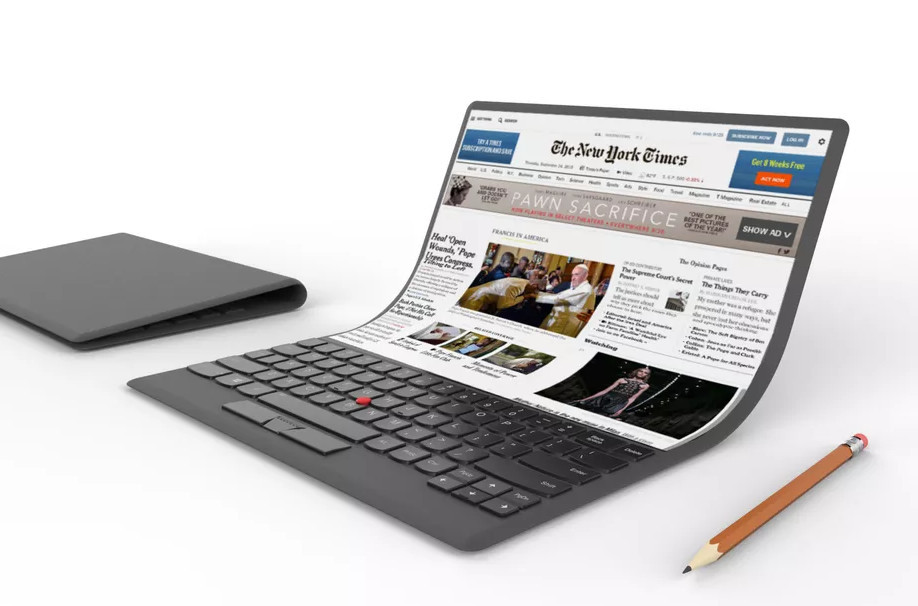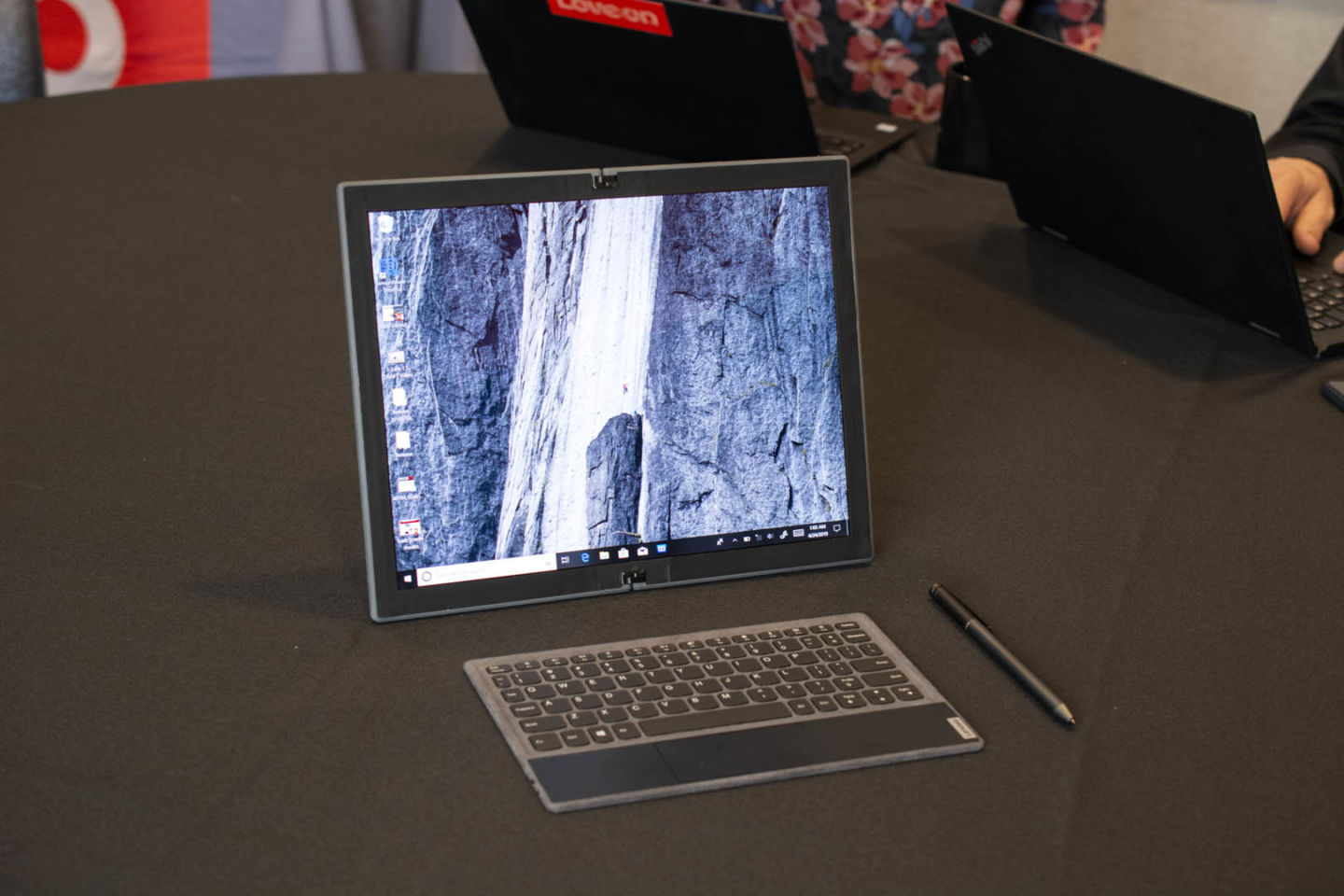How it all began: flexible and foldable displays - the story of the emergence and exit "in people"

Samsung introduced the foldable Galaxy Fold smartphone, and Huawei immediately responded to it with a flexible model, Mate X. Other companies are developing devices, and not only smartphones, Lenovo announced the imminent appearance of a laptop with a folding display . Folding screens - one of the varieties of flexible displays, however, the flexible there is not all, but only one area. So far such matrices are still rare, so there are more questions about them than answers, but we will try to sort it out.
From dream to real prototypes
The first were science fiction. In the books and movies, the main characters used the most unusual devices, among which were gadgets with flexible and folding screens of all colors and sizes.
1974 - the first real attempt
')
The practical implementation of the idea was proposed by Xerox, or rather, one of its divisions - PARC. The developers have created a flexible e-paper Gyricon . It appeared in 1974, the technology was the beginning of the evolutionary path of flexible displays. "Paper" consisted of polyethylene spheres from 20 to 100 microns in diameter. Each sphere was composed of a negatively charged black and a positively charged white half. All spheres were placed in a transparent silicone sheet, which was filled with oil so that the spheres rotated freely. The polarity of the applied voltage on each pair of electrodes determined which side the sphere would turn, thus giving the white or black color of the dot on the display. Gyricon was flexible; it was possible to erase and rewrite the image on the sensitive layer thousands of times.
1989 - Gyricon as a flexible display option.

Gyricon e-paper, 1989 version. Source: omputerworld
Nicholas Sheridan, working at the Xerox Palo Alto Research Center (PARC), was looking for an opportunity to rid the offices of paper by providing an alternative — electronic paper that could withstand thousands of cycles of use. Gyricon, in his opinion, was an excellent candidate for this role. In 1989, he had a new idea - to develop flexible displays based on his invention.
90s of the 20th Century - Xerox Tries to Promote Its Flexible Displays

In the 90s of the last century, technology was patented and they began to work on the project more actively. True, the use of such displays for commercial purposes was first tried only in 2003. Xerox was hoping that it would soon be possible to start mass deliveries of flexible Gyricon-based displays to the market, especially since mobile phones began to appear in large quantities, for which a flexible display was an excellent option, because flexible material would not break, it would not glass. Unfortunately, the cost of displays from Xerox was too high for it to interest the vendors of electronic devices. The project was decided to close in 2005, but Xerox still holds the patent.
2005 - new development from HP
In 2005, another team of researchers, this time from HP, began working on a flexible color display. But this project also had to be closed, because the developers did not have time to prepare a working demonstration prototype by the planned deadline. HP has remained technology with which the company tried to work. But in 2010 the direction was finally closed, because it turned out that thin and light glass screens are more profitable than more massive flexible screens .
2010 - Samsung's color flexible display
In 2010, Samsung showed an excellent color flexible display that displayed all the colors bright and juicy. The screen size was 4.5 inches, and its resolution was 800 x 480 pixels. After that demonstration, it became clear that within a few years flexible displays would enter the market.
A flexible E-ink display developed by the Human Media Lab company followed. It was not just flexible - sensors located in the screen, tracked the degree of bending of the surface, producing an electrical signal as feedback.
This made it possible to develop screens that performed certain actions in response to user effort. For example, having bent the right corner, it was possible to return to the previous page, the left - to launch the application.
There was even a flexible phone with an E-ink screen that bent in response to an incoming call or message. Thus, a person could immediately understand that someone wants to contact him.
Unfortunately, both technologies were very raw. It was just a demonstration of the capabilities of engineers, so all this did not go into production, remaining at the level of the concept. It was still impossible to develop a real device that could become popular at that level of development of flexible displays.
2013-2017 - the emergence of modern promising projects
A similar concept was the Nokia flexible phone, introduced in 2011. Then Samsung created its own concept, showing a prototype in 2013.
This South Korean company began to actively develop and promote the idea of flexible screens for smartphones. No less zealously rushed to reinvent the "bicycle" and LG. At CES 2013, the company demonstrated several devices with flexible screens. These were already quite functional gadgets. A little later, one of the technologies - a rounded screen around the edges, covered with ordinary glass - became part of the Samsung product line as Edge smartphones.
Over the next few years, companies continued to demonstrate concepts until, in 2017, Sony introduced the first commercial product, the FES Watch U smart watch with a curved E-ink screen with integrated electronic components. Actually, the watch was a screen - both the dial and the strap. The user could change both the color of the entire device and its individual elements.

There were a lot of concepts, it’s just impossible to list everything in one article. And most of them have remained projects, ideas that have never been implemented.
Real projects, not proof of concept
The first was a little-known startup Royole. The company showed its phone at CES in January 2019 and soon launched it for sale . The diagonal of the gadget in the unfolded state is 7.8 inches. According to a journalist who tried the device at work, the gadget turned out to have many flaws, the product was raw.
Then came the turn of Samsung with its Galaxy Fold. The company announced the device at the end of January 2019, announcing the price - $ 1980 .

The corporation sent the device to Western media reporters, who quickly discovered a large number of flaws in the design of the device.

A similar smartphone Huawei received the name Mate X.
According to the company, the device can be folded about 100,000 times without any harm. True, Samsung said about the same, but as it turned out, not everything is so simple.
Another phone with a folding display introduced Xiaomi - Mi Flex Dual. Its display consists of three parts, not two. While this is a working concept, and its value is unknown.

Lenovo has told about the upcoming laptop with a folding display. This is a nameless yet representative of the ThinkPad X1 family, which will only be available next year. Some characteristics of the display are known. Screen size - 13.3 inches, type - OLED, resolution - 1920 × 1440. The screen will be made for Lenovo by LG.
Another was called Nubia Alpha. The flexible screen allows you to wear a gadget on the arm on a watch. The device has the functions of a smartphone and will cost 499 euros. With it, you can make calls, send and receive messages, watch movies, take pictures.
Why so expensive
Firstly, because companies are investing a lot of money in the development of new technologies. Only Samsung has invested at least $ 2 billion over several years in the current technology of flexible OLED displays. The company hopes to return all this, so that phones with flexible screens cannot be cheap.
Secondly, the main material for OLED displays — indium tin oxide — is expensive. A kilogram costs about $ 800, and the cost is constantly increasing as demand increases.
Thirdly, so far companies have been producing devices with flexible and folding screens in small batches. The smaller the supply, the higher the cost of a single device.
Fourthly, in spite of the fact that the devices of the new type are few, huge sums are invested in their advancement. These funds must be returned, so they are also part of the price of the device.
What is the difficulty of production
Details of the production company do not disclose. But the difficulty is not only that you just need to make the displays flexible or foldable. It also means that it is necessary to look for new materials for the case, think about energy saving (the larger screen consumes a lot of energy) and develop new technical processes.
The same Samsung corporation introduced the first flexible OLED screens six years ago . The OLED display itself is a complex and delicate structure that cannot be exposed to strong external influences. This display is the thinnest film of organic material between the electrodes, which deliver energy to individual pixels. Electricity activates a pixel or turns it off.
Classic OLED-matrix in a regular phone can not be bent without harm to the intermediate layers. When bending, the conductive layer will change its characteristics, and such a screen will not work normally. In order for the display to continue to work in the folded state, we need a special filler, a structure that creates something like a flexible frame that holds all the elements in place even during bending.
And this is only part of the problem, since the touch is also an important element of the screen: the touch surface should not lose its properties during deformation.
Plus, as the surface of the display increases, its power consumption grows, so developers have to look for new ways to increase the energy efficiency of devices. They should not be discharged faster than a modern user is used to. Otherwise, no one will buy new phones.
Why tech product is not popular
One of the main problems is the high cost of devices. It is impossible to solve it right now, because a lot of money has been invested in technology, and they must be returned. And the device is released in very small batches.
The second difficulty is the technical imperfection of devices. This can be judged by what happened Samsung Galaxy Fold. Despite the assurances of the manufacturer that bending / unbending the screen can be a thousand times without harm, the reality was different. In the very first days, devices began to break down that got tested by techno-media journalists. The screen was even damaged by dust inside, not to mention the mechanical effect on the display. The company promised to solve this problem after Samsung engineers studied the failed phones and understood the reason. It is clear that no one will give a guarantee that after entering mass sales no other problems will appear.
The third is demand uncertainty. While paying a lot of money for unusual devices, which, moreover, are still breaking down, only geek enthusiasts are ready. And if they don’t buy phones, the technology will remain unclaimed. The problem can be solved only by reducing the price, increasing reliability and conducting successful marketing campaigns.
Samsung representatives predict that by 2022 the market for flexible displays will grow at least four times. But in fact, the company voiced its own expectations. Having invested several billion dollars in the project, the corporation hopes to discourage them in the future. In fact, he does not know how successful and sought is this solution.
Source: https://habr.com/ru/post/455268/
All Articles